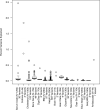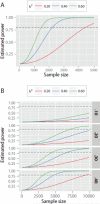Endophenotype best practices
- PMID: 27473600
- PMCID: PMC5219856
- DOI: 10.1016/j.ijpsycho.2016.07.516
Endophenotype best practices
Abstract
This review examines the current state of electrophysiological endophenotype research and recommends best practices that are based on knowledge gleaned from the last decade of molecular genetic research with complex traits. Endophenotype research is being oversold for its potential to help discover psychopathology relevant genes using the types of small samples feasible for electrophysiological research. This is largely because the genetic architecture of endophenotypes appears to be very much like that of behavioral traits and disorders: they are complex, influenced by many variants (e.g., tens of thousands) within many genes, each contributing a very small effect. Out of over 40 electrophysiological endophenotypes covered by our review, only resting heart, a measure that has received scant advocacy as an endophenotype, emerges as an electrophysiological variable with verified associations with molecular genetic variants. To move the field forward, investigations designed to discover novel variants associated with endophenotypes will need extremely large samples best obtained by forming consortia and sharing data obtained from genome wide arrays. In addition, endophenotype research can benefit from successful molecular genetic studies of psychopathology by examining the degree to which these verified psychopathology-relevant variants are also associated with an endophenotype, and by using knowledge about the functional significance of these variants to generate new endophenotypes. Even without molecular genetic associations, endophenotypes still have value in studying the development of disorders in unaffected individuals at high genetic risk, constructing animal models, and gaining insight into neural mechanisms that are relevant to clinical disorder.
Keywords: Biomarker; Candidate gene; Data sharing; Endophenotype; GREML; GWAS; Genes; Heritability.
Copyright © 2016 Elsevier B.V. All rights reserved.
Figures



Similar articles
-
Endophenotype trait domains for advancing gene discovery in autism spectrum disorder.J Neurodev Disord. 2023 Nov 22;15(1):41. doi: 10.1186/s11689-023-09511-y. J Neurodev Disord. 2023. PMID: 37993779 Free PMC article. Review.
-
Electrophysiological Endophenotypes for Schizophrenia.Harv Rev Psychiatry. 2016 Mar-Apr;24(2):129-47. doi: 10.1097/HRP.0000000000000110. Harv Rev Psychiatry. 2016. PMID: 26954597 Free PMC article. Review.
-
Knowns and unknowns for psychophysiological endophenotypes: integration and response to commentaries.Psychophysiology. 2014 Dec;51(12):1339-47. doi: 10.1111/psyp.12358. Psychophysiology. 2014. PMID: 25387720 Free PMC article. Review.
-
Quantitative trait locus analysis for endophenotypes reveals genetic substrates of core symptom domains and neurocognitive function in autism spectrum disorder.Transl Psychiatry. 2022 Sep 24;12(1):407. doi: 10.1038/s41398-022-02179-3. Transl Psychiatry. 2022. PMID: 36153334 Free PMC article.
-
Genome-wide linkage and association analysis of primary open-angle glaucoma endophenotypes in the Norfolk Island isolate.Mol Vis. 2017 Sep 28;23:660-665. eCollection 2017. Mol Vis. 2017. PMID: 28966548 Free PMC article.
Cited by
-
Forgetting Unwanted Memories: Active Forgetting and Implications for the Development of Psychological Disorders.J Pers Med. 2021 Mar 26;11(4):241. doi: 10.3390/jpm11040241. J Pers Med. 2021. PMID: 33810436 Free PMC article. Review.
-
Conflict-related medial frontal theta as an endophenotype for alcohol use disorder.Biol Psychol. 2018 Nov;139:25-38. doi: 10.1016/j.biopsycho.2018.10.002. Epub 2018 Oct 6. Biol Psychol. 2018. PMID: 30300674 Free PMC article.
-
Faster bi-stable visual switching in psychosis.Transl Psychiatry. 2024 May 7;14(1):201. doi: 10.1038/s41398-024-02913-z. Transl Psychiatry. 2024. PMID: 38714650 Free PMC article.
-
Reduced premovement positivity during the stimulus-response interval precedes errors: Using single-trial and regression ERPs to understand performance deficits in ADHD.Psychophysiology. 2019 Sep;56(9):e13392. doi: 10.1111/psyp.13392. Epub 2019 May 12. Psychophysiology. 2019. PMID: 31081153 Free PMC article.
-
Minnesota Center for Twin and Family Research.Twin Res Hum Genet. 2019 Dec;22(6):746-752. doi: 10.1017/thg.2019.107. Epub 2019 Dec 3. Twin Res Hum Genet. 2019. PMID: 31796137 Free PMC article.
References
-
- Anokhin AP, Golosheykin S, Heath AC. Genetic and environmental influences on emotion-modulated startle reflex: a twin study. Psychophysiology. 2007;44:106–112. doi: 10.1111/j.1469-8986.2006.00486.x. - PubMed
-
- Anokhin AP, Heath AC, Myers E, Ralano A, Wood S. Genetic influences on prepulse inhibition of startle reflex in humans. Neurosci Lett. 2003;353:45–48. - PubMed
Publication types
MeSH terms
Grants and funding
LinkOut - more resources
Full Text Sources
Other Literature Sources

